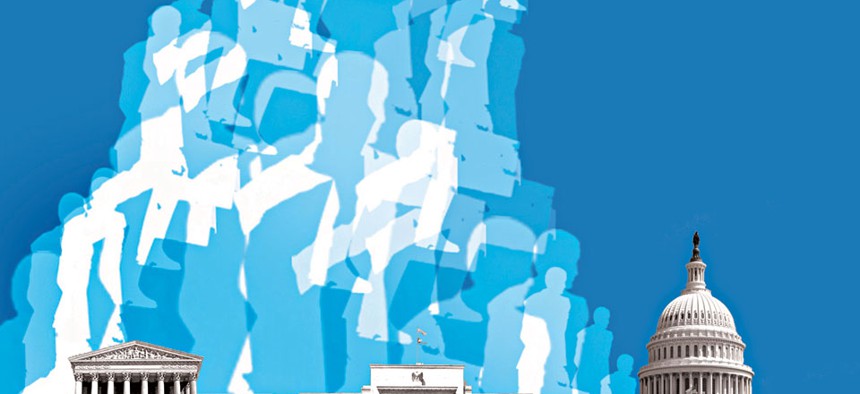
Anastasia Vasilakis
After the Wave
If workers in their 50s retire, who will be left to steer the ship?
You’ve likely heard of the impending government retirement wave. For a decade, agency leaders have been monitoring their workforce demographics with increasing concern. Lower attrition rates and less hiring have produced a static employee base that grows older each year.
Many employees put retirement on hold during the economic and federal budget crises. This may delay any mass exodus from federal staffs, but it will increase the size of the wave in years to come. As agencies tweak workforce plans to account for these trends, they’ve rightly planned for the departure of their oldest employees. But they also need to consider employees younger than age 60, whose exit represents the single biggest risk to the continuity of operations.
There are roughly 650,000 federal workers in their 50s—twice the size of the group that is age 60 and older. Many employees in their late 50s leave the civil service soon after they become retirement eligible. Many who want to continue working full time use their federal pension as a financial cushion while they seek opportunities in the private sector. Before the financial crisis, employees in their 50s accounted for roughly half of all federal retirements. By 2013, the number had dropped to 35 percent. So, during the past five years, tens of thousands of employees in their late 50s who otherwise might have left the federal workforce (based on attrition levels before the economic downturn) have decided to stay.
There are three primary factors that led these employees to delay retirement.
First, the retirement system has changed. Actually, it changed in 1987 when the Federal Employees Retirement System was created, but the ripple effects are just starting as the first batch of workers under FERS become retirement eligible. The new system provides greater retirement account portability through the Thrift Savings Plan and places less emphasis on tenure, in the form of smaller and less progressive multipliers on the basic annuity. These features combined with pay freezes during the last three years have eroded the incentive to stay in the civil service.
The bigger economic picture has also affected retirement decisions. Stock market and housing prices declined during the financial crisis, factors that account for most personal wealth. Retirement-eligible employees with smaller nest eggs—and, in some cases, with underwater mortgages—have lacked the confidence to make major career moves or stop working. The situation has changed in the past few years, however. Stocks have more than doubled after hitting lows in early 2009, and real estate prices also have climbed. In addition, private sector hiring has picked up, which presents more post-government employment options.
Not least among the reasons to expect an acceleration of retirements is employee morale. After three successive years of partisan gridlock, cutbacks, furloughs and an overall degradation in the perception of government, morale among federal employees continues to plummet. Some employees will stay at their agencies despite such developments, but those who are retirement eligible will increasingly vote with their feet.
Many agencies are rightly planning for the departures of their oldest workers, but few have considered what will happen when those workers’ successors depart as well. Without the strong federal employment value proposition of years past, there’s little doubt that more people will retire from federal service at a younger age. The strongest agencies will be the ones that can answer the question: Who will be the successor to the successor?
Adam Cole is senior director at CEB, a member-based advisory company.
NEXT STORY: The Science of Slackers






